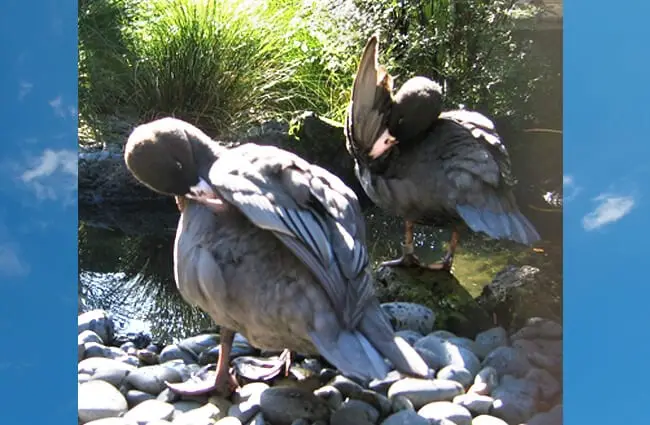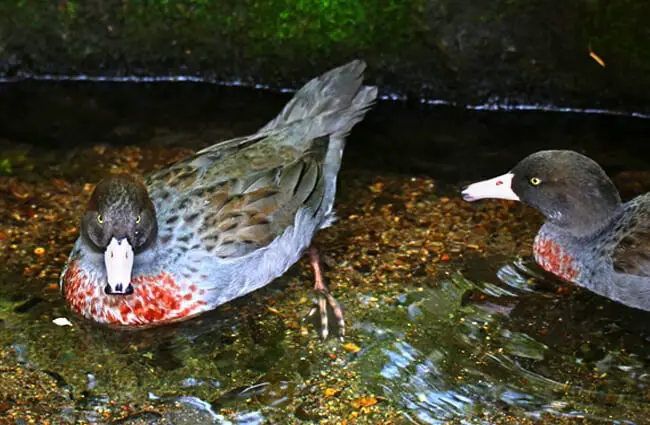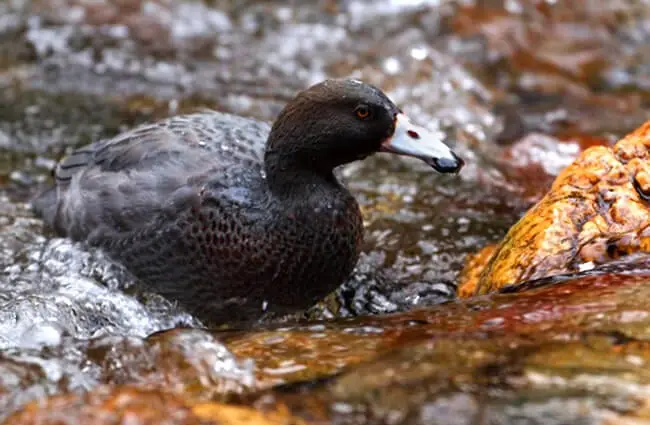A Deep Dive into the World of the Blue Duck
The Blue Duck, or Hymenolaimus malacorhynchos, is a unique and captivating waterfowl native to New Zealand. Often overlooked, this duck possesses a remarkable story of adaptation, resilience, and ecological importance. This guide explores everything from its distinctive features and habitat to its complex behaviors and current conservation status. Prepare to be amazed by the fascinating world of this endemic species.

What Makes a Blue Duck a Blue Duck?
At first glance, the Blue Duck isn't particularly striking in plumage. Both males and females exhibit a mottled greyish blue coloration, hence the common name. However, a closer look reveals several key characteristics. The most noticeable is the striking, bright blue patch on the male's bill during breeding season. This feature, along with the absence of the mirror patch (a speculum of iridescent feathers) typically found on other duck species, sets it apart. The bill itself is also uniquely adapted for its feeding habits, being broad and flattened with fleshy papillae along the edges. Adults typically weigh between 900g and 1.3kg, with a wingspan of approximately 75-90cm.
Habitat and Distribution
The Blue Duck is intimately tied to New Zealand's fast flowing rivers and streams. Unlike many other duck species that prefer lakes and ponds, the Blue Duck thrives in turbulent, oxygen rich waters. This preference dictates its distribution, which is largely confined to the North and South Islands of New Zealand. Historically, they were found throughout both islands, but populations have become fragmented and localized due to habitat loss and introduced predators. They favor areas with native forest cover along the riverbanks, which provide shelter and nesting sites. The optimal habitat includes clear, rocky streambeds with abundant invertebrate life.
![A Whio (Blue Duck) Photo by: Karora [Public domain]](https://animals.net/wp-content/uploads/2019/07/Blue-Duck-4-650x425.jpg)
Diet and Foraging Behavior
The Blue Duck's diet primarily consists of aquatic invertebrates. Insects, larvae, snails, and crustaceans are its main food. Its specialized bill is perfectly suited for filtering these creatures from the riverbed. They forage by diving and walking along the streambed, using their bill to probe for food. Unlike many ducks that dabble or upend, the Blue Duck rarely floats on the surface to feed. They are incredibly efficient foragers, capable of locating and consuming invertebrates even in strong currents. This specialization makes them a vital component of the river ecosystem, helping to control invertebrate populations.
Evolutionary History
The Blue Duck holds a unique position in the waterfowl family. It is the sole surviving member of the Hymenolaimus genus, representing an ancient lineage distinct from other duck groups. Fossil evidence suggests that its ancestors were present in New Zealand for millions of years. Its evolutionary isolation and specialized adaptations reflect the unique environmental conditions of New Zealand. Genetic studies confirm its distinct evolutionary trajectory, highlighting the importance of preserving this ancient lineage. Some researchers believe that the Blue Duck may represent a living fossil, providing insights into the early evolution of waterfowl.
Mating and Reproduction
Blue Ducks typically form monogamous pair bonds, often lasting for several seasons. Breeding occurs between August and December, coinciding with warmer weather and increased food availability. The female constructs a nest in a sheltered location near the riverbank, often concealed within vegetation or a hollow log. Clutches typically contain 4-8 eggs, which are incubated for approximately 35-40 days. Both parents participate in raising the ducklings, providing them with food and protection. Ducklings are precocial, meaning they are relatively independent and able to feed themselves shortly after hatching. They are particularly vulnerable to predation during their first few weeks of life.

Ecological Role and Interactions
The Blue Duck plays a crucial role in maintaining the health of New Zealand's river ecosystems. As a key predator of aquatic invertebrates, it helps regulate their populations. Its foraging activities also contribute to nutrient cycling within the river. Blue Ducks can coexist with other waterfowl species, but they generally occupy a different niche due to their specialized feeding habits and habitat preferences. They may compete with other ducks for nesting sites, however. Predators such as stoats, ferrets, and cats pose a significant threat to Blue Duck populations, particularly to eggs and ducklings.
Blue Ducks and Human Interaction
Historically, Blue Ducks were a food source for Māori, who sustainably harvested them. However, with the arrival of European settlers, populations declined dramatically due to habitat loss, hunting, and the introduction of mammalian predators. Today, the Blue Duck is nationally vulnerable and is the subject of intensive conservation efforts. These efforts include predator control, habitat restoration, and captive breeding programs. The Department of Conservation actively monitors Blue Duck populations and works with landowners and communities to protect their habitat.
Spotting a Blue Duck in the Wild
If venturing into suitable Blue Duck habitat, look for fast flowing rivers and streams with native forest cover. They are most active during daylight hours, foraging and preening along the riverbank. Listen for their distinctive, high pitched whistling call. Remember to observe from a distance and avoid disturbing their habitat. Reporting any sightings to the Department of Conservation can contribute to monitoring efforts.

Caring for Blue Ducks in Captivity
Zookeepers caring for Blue Ducks need to replicate their natural environment as closely as possible. This includes providing a large, flowing water exhibit with rocky substrate and native vegetation. A varied diet of aquatic invertebrates, supplemented with formulated waterfowl feed, is essential. Regular health checks and preventative veterinary care are crucial. Providing enrichment activities, such as foraging opportunities and nesting materials, can promote their well being. Avoid overcrowding and ensure adequate space for each individual.
Interesting Facts About the Blue Duck
- Blue Ducks can dive underwater for up to 30 seconds.
- They are capable of walking long distances along riverbanks.
- The male's blue bill becomes more vibrant during breeding season.
- Ducklings are able to swim and dive shortly after hatching.
- Blue Ducks are highly territorial and will defend their foraging areas.
- They play an important role in Māori culture and folklore.

The Blue Duck is a remarkable species, embodying resilience and adaptation. Its unique characteristics, ecological role, and cultural significance make it a treasured part of New Zealand's natural heritage. By understanding and appreciating this fascinating waterfowl, we can contribute to its long term conservation and ensure that it continues to thrive in the wild.

![Red Angus Closeup of a beautiful Red Angus cowPhoto by: U.S. Department of Agriculture [pubic domain]https://creativecommons.org/licenses/by/2.0/](https://animals.net/wp-content/uploads/2020/03/Red-Angus-4-238x178.jpg)




![Red Angus Closeup of a beautiful Red Angus cowPhoto by: U.S. Department of Agriculture [pubic domain]https://creativecommons.org/licenses/by/2.0/](https://animals.net/wp-content/uploads/2020/03/Red-Angus-4-100x75.jpg)

